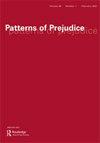国家社会主义黑金属:重金属亚文化中极右翼意识形态的延续案例研究
IF 0.8
2区 社会学
Q4 ETHNIC STUDIES
引用次数: 2
摘要
摘要国家社会主义黑金属(NSBM)于20世纪90年代初作为更广泛的黑金属运动的一个附属流派出现。NSBM以宣扬雅利安人优越感、异教徒精神和反对全球化的主题内容而闻名。Buesnel的文章通过对Graveland(波兰)和Absurd(德国)乐队的分析,探讨了NSBM早期运动的历史,这两个乐队在NSBM流派的建立中都发挥了至关重要的作用。Buesnel强调了金属亚文化中国家社会主义意识形态的现状,并对重金属中极右翼极端主义的未来进行了观察。本文章由计算机程序翻译,如有差异,请以英文原文为准。
National Socialist Black Metal: a case study in the longevity of far-right ideologies in heavy metal subcultures
ABSTRACT National Socialist Black Metal (NSBM) emerged in the early 1990s as a subsidiary genre of the broader black metal movement. NSBM is distinguished by thematic content that promotes Aryan superiority, pagan spirituality and opposes globalization. Buesnel’s article explores the history of the early NSBM movement through an analysis of the bands Graveland (Poland) and Absurd (Germany), which have both played vital roles in the establishment of the NSBM genre. Buesnel highlights the current state of National Socialist ideology within metal subcultures and concludes with observations about the future of far-right extremism in heavy metal.
求助全文
通过发布文献求助,成功后即可免费获取论文全文。
去求助
来源期刊

Patterns of Prejudice
Multiple-
CiteScore
2.50
自引率
0.00%
发文量
11
期刊介绍:
Patterns of Prejudice provides a forum for exploring the historical roots and contemporary varieties of social exclusion and the demonization or stigmatisation of the Other. It probes the language and construction of "race", nation, colour, and ethnicity, as well as the linkages between these categories. It encourages discussion of issues at the top of the public policy agenda, such as asylum, immigration, hate crimes and citizenship. As none of these issues are confined to any one region, Patterns of Prejudice maintains a global optic, at the same time as scrutinizing intensely the history and development of intolerance and chauvinism in the United States and Europe, both East and West.
 求助内容:
求助内容: 应助结果提醒方式:
应助结果提醒方式:


